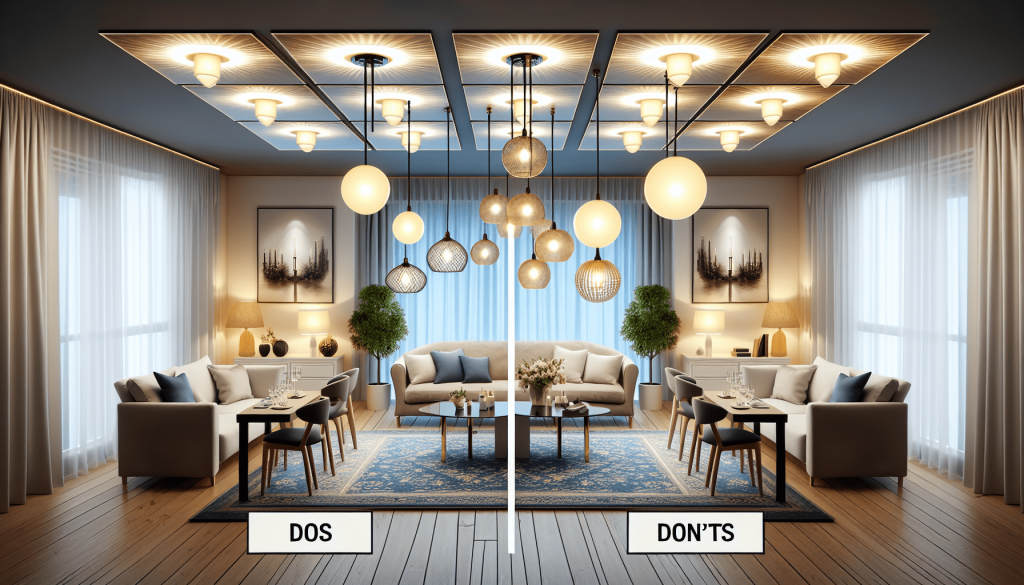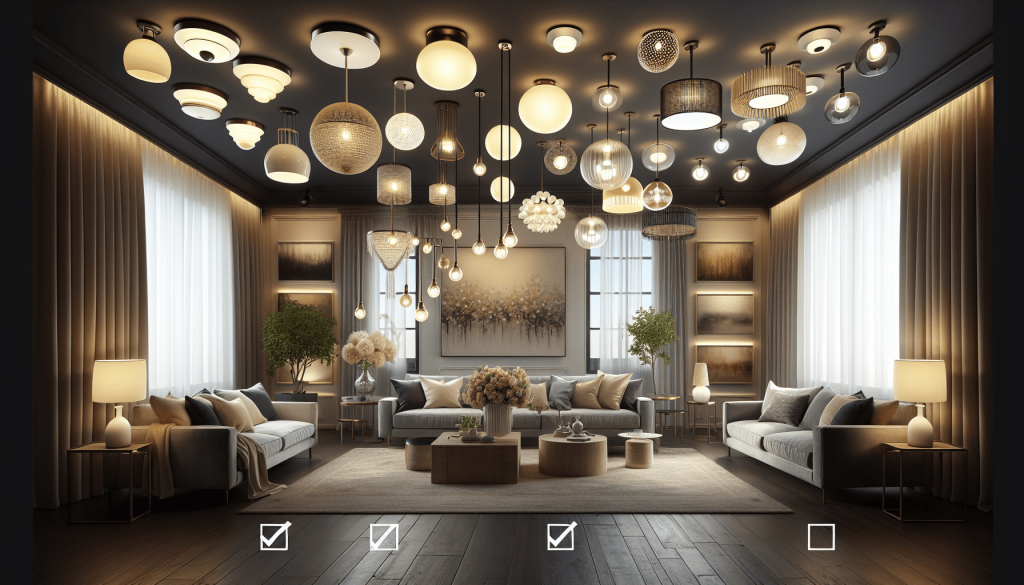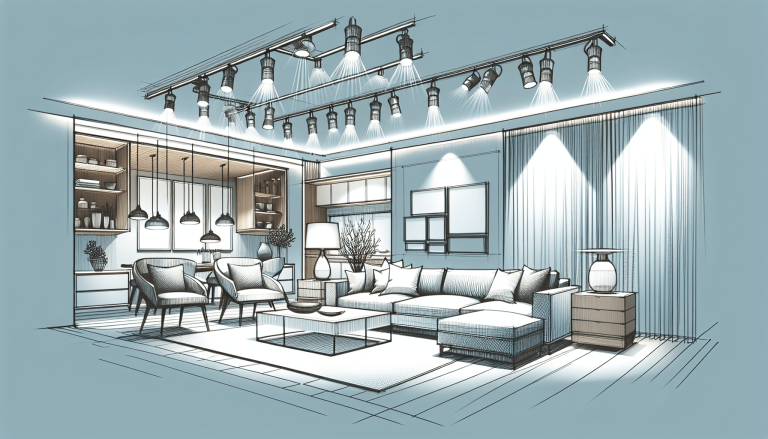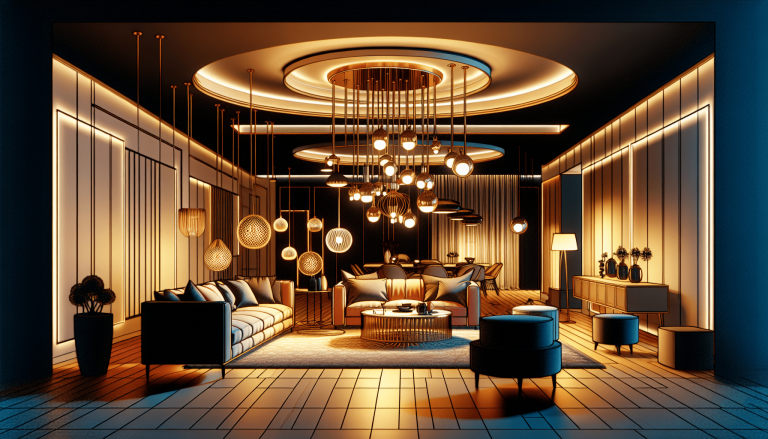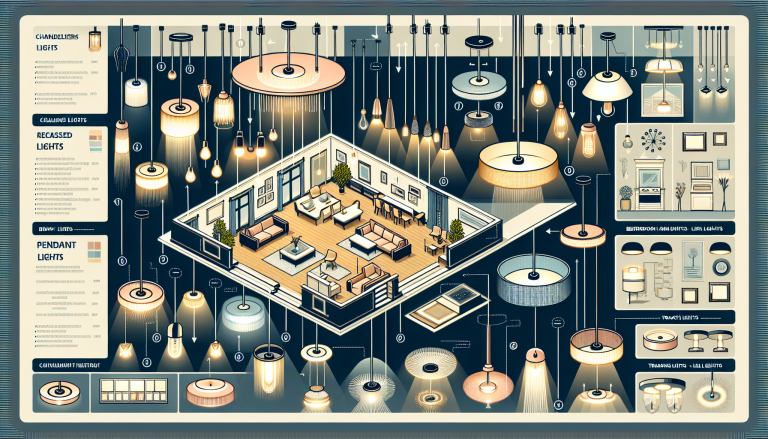In your quest to create the perfect ambiance in your home, a key element to consider is the type of ceiling lights you choose. Mixing different types of ceiling lights can add depth and dimension to any space, but it’s important to approach this task with caution. This article will guide you through the dos and don’ts of mixing different types of ceiling lights, helping you strike the perfect balance between functionality and style. Whether you’re aiming for a cozy and intimate atmosphere or a bright and lively one, understanding these tips will ensure that you achieve the desired effect while creating a visually appealing and well-lit environment in your home.
Table of Contents
ToggleUnderstanding Different Types of Ceiling Lights
If you’re looking to create a well-designed and properly illuminated space, understanding the different types of ceiling lights is essential. Ceiling lights play a vital role in setting the mood, highlighting specific areas, and providing overall illumination in a room. By using the right combination of ceiling lights, you can enhance the functionality and aesthetics of your space.
Types of Ceiling Lights
Ceiling lights come in various types that serve different purposes. Understanding these types will help you make informed decisions when planning your lighting design.
-
Pendant Lights: These hanging fixtures provide both task and ambient lighting. They are versatile and can be used individually or arranged in clusters for a dramatic effect.
-
Chandeliers: Traditionally used in grand spaces, chandeliers are elegant lighting fixtures that create a focal point in a room. They add a touch of luxury and sophistication.
-
Recessed Lights: Also known as can lights or downlights, recessed lights are installed into the ceiling, providing a sleek and seamless look. They are versatile and can be used for general lighting or to highlight specific areas.
-
Flush Mount Lights: These are ceiling lights that are mounted flush against the ceiling, making them ideal for spaces with low ceilings. They provide general lighting and come in a variety of styles.
-
Track Lighting: Track lights consist of a series of adjustable light fixtures mounted on a track. They are commonly used to highlight artwork or focal points in a room.
-
Sconces: Wall-mounted lights that provide both functional and decorative lighting. They can be used to flank mirrors, highlight architectural features, or illuminate hallways.
Importance of Understanding Different Types
Understanding the different types of ceiling lights is important for several reasons. Firstly, it allows you to select the most appropriate lighting type for each area of your space. Different activities and moods require different lighting, and having a variety of ceiling lights at your disposal will ensure you can create the desired atmosphere.
Additionally, understanding the different types of ceiling lights enables you to harmonize them effectively. Mixing and matching ceiling lights can create a layered and dynamic lighting design that enhances the overall aesthetic appeal of the space.
Dos: Harmonizing Ceiling Lighting Types
When it comes to mixing different types of ceiling lights, there are certain dos and don’ts to keep in mind. By following these guidelines, you can create a harmonious and visually pleasing lighting design.
Select a Dominant Lighting Type
Start by selecting a dominant lighting type that will serve as the main source of illumination in the room. This could be a chandelier, pendant lights, or recessed lights. The dominant lighting type should complement the overall style and purpose of the space.
Complementing Secondary Lighting Types
Once you have chosen the dominant lighting type, select secondary lighting types that complement it. For example, if you have a chandelier as the dominant lighting type, you can use wall sconces or pendant lights as secondary lighting to provide additional illumination and create a cohesive look.
Balancing Light Intensity
When mixing different types of ceiling lights, it’s important to balance the light intensity. Avoid having one type of light overpowering the others. Consider the purpose of each lighting type and adjust the intensity accordingly. For example, task lighting should be brighter for areas where concentration is required, while ambient lighting should be softer for relaxation areas.
Using Color Temperature Effectively
Color temperature refers to the warmth or coolness of the light emitted by a bulb or fixture. When mixing ceiling lights, consider using bulbs with similar color temperature to create a cohesive look. Warm white light creates a cozy and inviting atmosphere, while cool white light is more energizing and suitable for task-oriented areas.
Don’ts: Mixing Incompatible Ceiling Lighting Types
While mixing different types of ceiling lights can create a stunning lighting design, there are certain don’ts to be aware of to avoid visual chaos and imbalance.
Avoid Randomly Mixing Types
Mixing ceiling lights randomly without considering their compatibility can result in a cluttered and disjointed look. Each type should have a purpose and complement the overall design of the space. Be intentional in your choices and ensure that each type of lighting contributes to the overall aesthetic.
Steer Clear of Clashing Styles
Mixing incompatible styles of ceiling lights can create visual disharmony. Stick to a consistent style or theme throughout your lighting design to maintain a cohesive look. If your space has a contemporary style, opt for modern and sleek lighting fixtures, while traditional spaces can benefit from more ornate and classic fixtures.
Consider Spatial Compatibility
When mixing different types of ceiling lights, consider the spatial compatibility of each lighting type. Some fixtures may be better suited for larger rooms or higher ceilings, while others may work well in smaller spaces. Take into account the scale and proportion of the space when selecting ceiling lights to ensure they fit seamlessly into the overall design.
Avoid Overcrowding
While it can be tempting to incorporate multiple types of ceiling lights, overcrowding can result in a cluttered and chaotic look. Be mindful of the space available and choose lighting fixtures that will enhance the functionality and aesthetics of the room without overwhelming it. Remember, sometimes less is more.
Considerations when Mixing Ceiling Lights
When mixing different types of ceiling lights, there are several considerations to keep in mind to achieve a cohesive and visually pleasing result.
Matching Purpose and Mood
Consider the purpose and mood of each area when selecting ceiling lights to mix. Task-oriented areas such as kitchens and bathrooms may require brighter lighting, while living rooms and bedrooms may benefit from softer and more ambient lighting. By matching the purpose and mood of the space, you can create a harmonious environment.
Coordinating Design Elements
Ensure that the design elements of the ceiling lights coordinate with the overall design of the space. Consider factors such as the finish, material, and shape of the fixtures. By coordinating these elements, you can create a cohesive and well-designed lighting scheme that enhances the overall aesthetic.
Considering Ceiling Height and Space
Ceiling height and space are important factors to consider when mixing ceiling lights. Higher ceilings allow for more dramatic lighting fixtures such as chandeliers or pendant lights, while lower ceilings may require flush mount or recessed lights. Additionally, the size of the room should also be taken into account to ensure that the lighting fixtures are proportionate to the space.
Blending Traditional and Modern
Mixing traditional and modern ceiling lights can create an interesting and dynamic lighting design. However, it’s important to strike a balance between the two styles to avoid visual clashes. For example, pairing a contemporary pendant light with traditional wall sconces can create a harmonious blend of styles.
Thinking Long-Term
When mixing different types of ceiling lights, consider the long-term implications. Lighting trends may change over time, so opt for timeless and versatile fixtures that will remain relevant even as design styles evolve. Investing in high-quality and durable lighting fixtures will ensure that your lighting design withstands the test of time.
Dos: Layering Ceiling Lights
Layering ceiling lights is an effective way to create depth and dimension in a room. By combining different types of lighting, you can achieve a well-balanced and visually appealing result.
Task Lighting
Task lighting refers to lighting that is specific to certain activities such as reading, cooking, or working. It provides focused and concentrated illumination. Incorporate task lighting into your ceiling design by using pendant lights or recessed lights to provide ample brightness in areas where tasks are performed.
Accent Lighting
Accent lighting is used to highlight specific features or objects in a room, such as artwork, architectural details, or decorative items. This type of lighting adds drama and visual interest to a space. Use track lighting or adjustable recessed lights to create focused beams of light that draw attention to key areas.
Ambient Lighting
Ambient lighting provides overall illumination and sets the general mood of a space. It creates a comfortable and inviting atmosphere. Incorporate ambient lighting into your ceiling design by using chandeliers, flush mount lights, or recessed lights with wide beam angles. Ensure that the ambient lighting is evenly distributed throughout the room.
Decorative Lighting
Decorative lighting serves as a statement piece and adds a touch of personality to a space. It can be a chandelier, a pendant light with an intricate design, or a unique ceiling fixture. Incorporate decorative lighting into your ceiling design to create a focal point and make a visual impact.
Don’ts: Ignoring Balance and Proportion
When layering different types of ceiling lights, it’s important to maintain balance and proportion to avoid overwhelming or underwhelming the space.
Avoiding Overpowering Dominant Lights
If you have a dominant lighting type, such as a chandelier or a large pendant light, be cautious not to overpower the space with its brightness or size. Consider the scale of the room and ensure that the dominant light is proportionate to the space. Use dimmers or adjustable bulbs to control the intensity if needed.
Balancing Light Distribution
When layering different types of ceiling lights, ensure that the light distribution is balanced throughout the room. Avoid concentrating all the light in one area while leaving other areas dimly lit. Experiment with different combinations of fixtures and adjust their positions and angles to achieve an even distribution of light.
Considering Ceiling Size and Height
The size and height of the ceiling should be taken into consideration when layering ceiling lights. Higher ceilings can accommodate larger fixtures and provide opportunities for creative lighting installations. On the other hand, lower ceilings may require smaller or flush mount fixtures to avoid a cramped appearance.
Tips for Mixing Different Ceiling Light Sizes and Heights
Mixing different ceiling light sizes and heights can create visual interest and add dimension to a space. Here are some tips to help you achieve a balanced and aesthetically pleasing result.
Grouping Lights of Similar Sizes
If you’re using multiple pendant lights or chandeliers, consider grouping them together to create a cohesive and visually appealing arrangement. Group lights of similar sizes to maintain a sense of balance and proportion. This technique works well in dining areas or above kitchen islands.
Using Varying Heights to Create Visual Interest
Mixing ceiling lights at varying heights can create a dynamic and visually interesting effect. For example, you can hang pendant lights at different heights over a staircase or in a foyer. This creates a stunning focal point and adds depth to the space.
Avoiding Extreme Disparity in Heights
While varying heights can be visually appealing, it’s important to strike a balance and avoid extreme disparities. A subtle difference in heights between ceiling lights can create a harmonious and balanced look. However, if the difference is too extreme, it may create an awkward and unbalanced appearance.
Dos: Creating a Focal Point
Creating a focal point in a room adds intrigue and draws attention to specific areas or features. Ceiling lights can be used to create a focal point and enhance the overall design of the space.
Choosing a Central Lighting Piece
Select a central lighting piece, such as a chandelier or a large pendant light, to serve as the focal point in the room. Place it strategically in a prominent spot, such as the center of the room or above a dining table, to create a visual centerpiece.
Highlighting Key Areas
Use ceiling lights to highlight key areas in the room that deserve special attention. For example, you can use recessed lights or track lighting to showcase artwork on the walls or architectural features such as exposed beams or decorative moldings.
Drawing Attention to Architectural Features
Ceiling lights can also be used to draw attention to architectural features in a space. For example, recessed lights can be installed to accentuate a vaulted ceiling or an interesting ceiling design. By highlighting these features, you add depth and character to the room.
Don’ts: Neglecting Lighting Controls
While selecting and mixing different types of ceiling lights is important, it’s equally important to consider lighting controls to enhance flexibility and functionality.
Not Considering Dimmers
Dimmers allow you to adjust the intensity of the lighting and create different moods and atmospheres in a room. Neglecting dimmers can result in limited control over the lighting. Install dimmer switches for your ceiling lights to have the ability to create both bright and soft lighting options.
Overlooking Smart Lighting Systems
Smart lighting systems provide advanced control over your ceiling lights. They allow you to adjust the lighting remotely, set timers, and even change the color temperature. Consider incorporating smart lighting systems into your ceiling design to enhance convenience and create personalized lighting experiences.
Conclusion
Mixing different types of ceiling lights can elevate the overall design and functionality of a space. By understanding the various types of ceiling lights and following the dos and don’ts, you can create a harmonious and visually appealing lighting design.
Remember to consider factors such as spatial compatibility, balance, and proportion when selecting and layering ceiling lights. Take into account the purpose and mood of each area and coordinate the design elements to maintain a cohesive look.
Finally, don’t overlook the importance of lighting controls. Install dimmers and consider incorporating smart lighting systems to enhance flexibility and personalize your space. By experimenting, personalizing, and seeking professional advice when needed, you can create a well-designed and inviting environment that truly shines.

